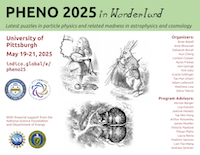Speaker
Description
Cosmological stasis is a phenomenon wherein the abundances of multiple cosmological energy components with different equations of state remain constant for an extended period despite the expansion of the universe. This stasis phenomenon can give rise to cosmological epochs in which the effective equation-of-state parameter $\langle w \rangle$ for the universe is constant, but differs from the canonical values associated with matter, radiation, vacuum energy, etc. Indeed, during such a stasis epoch, the spatial average of the energy density of the universe evolves in precisely the same manner as it would have evolved if the universe were instead dominated by a perfect fluid with an equation-of-state parameter equal to $\langle w\rangle$. In this talk, however, I demonstrate that this equivalence is broken at the perturbation level. As an example, I show that the density perturbations associated with a spectator matter component with an exceedingly small energy density exhibit power-law growth during an epoch of matter/radiation stasis. This growth can potentially lead to significant enhancements of structure at small scales. Such enhancements are not only interesting in their own right, but may also provide a way of observationally distinguishing between a stasis epoch and an epoch of perfect-fluid domination.

